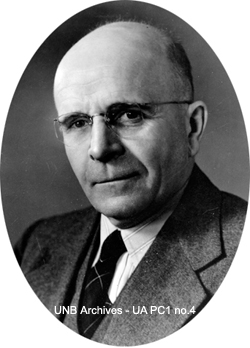University of New Brunswick"
by

Dean of Applied Science

|
KING’S
COLLEGE
CIVIL ENGINEERING, ETC. A course of
instruction in Civil Engineering will be given at King’s College by Mr.
McMahon Cregan, who has been appointed to that duty by His Excellency
the Visitor, and will commence on the fifteenth of February next, and
continue until the end of April. It will be open to students of
the
College on payment of a fee of ten shillings and to all others on
payment of a fee of two pounds, for the Course.
Persons desirous of joining the class are requested to communicate with the Registrar:–The course will embrace with other subjects, the following syllabus: “An explanation of the construction and uses of Logarithms, Sines, tangents, etc., Trigonometrical Formulae; Resolution of Plane Triangles; methods of Surveying with Theodolite, Circumferenter, etc. Construction, use and Adjustment of the Instruments used by the Engineers, both for field and office work; levelling: Method of determining best route for Railway, etc.; Computation of the quantities of land, earthwork, etc., required for the execution of the works; Horsepower of Machinery, etc.; Method of “setting out” Railway curves and side widths; Calculation of gradients and theory of inclined planes; Superelevation of rails; Composition and resolution of Forces; Calculation of strains and pressures; strength of materials; theory and practice of timber and iron framing viaducts, bridges, etc. Three lectures a week will be given in the College; and instruction in the field will also be given once a week, or as often as may be expedient.
CHARLES FISHER, Registrar
|
|
SPECIAL
UNDERGRADUATE COURSE OF STUDY
COURSE IN CIVIL ENGINEERING AND SURVEYING The undergraduate course of Civil Engineering and Surveying shall occupy at least three terms, at the end of which time, students may be admitted to examination for a diploma on producing a certificate signed by the head of the College, that they have pursued in the University, or in some other affiliated Institution of the University, the following Courses of study:–The English Language, Mathematics, General Physics, Chemistry, Practical Mechanics, Physical Geography and History, Mineralogy, Geology, Civil Engineering, Including the Principles of Architecture. |
| To all to whom
these Presents shall Come. I, William Brydone Jack, Doctor in
Civil
Law, and President of the University of New Brunswick, testify that
George Henry Clopper Ketchum [sic], who was a student in the Special
Undergraduate Course of Civil Engineering, in the late King’s College
(now the University of New Brunswick), having fulfilled the
requirements of the Statutes, is on this the fifth day of June, in the year
of our Lord one thousand eight hundred and sixty-two, presented with
this diploma, granted to students in Engineering in the said
University. In testimony whereof I herewith sign my name, and
cause
the Seal of the said University to be affixed. Given in the aforesaid University this fifth day of June A.D. 1862.
BRYDONE JACK, President
E.H. WILMOT, Registrar
|